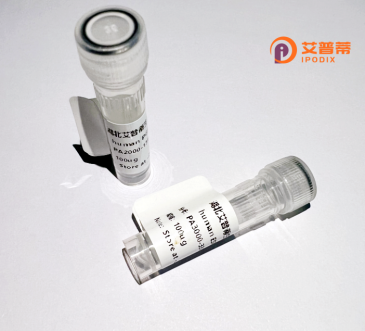
| 纯度 | >90%SDS-PAGE. |
| 种属 | Human |
| 靶点 | ZNF621 |
| Uniprot No | Q6ZSS3 |
| 内毒素 | < 0.01EU/μg |
| 表达宿主 | E.coli |
| 表达区间 | 1-439 aa |
| 活性数据 | MLQTTWPQESVTFEDVAVYFTQNQWASLDPAQRALYGEVMLENYANVASLVAFPFPKPALISHLERGEAPWGPDPWDTEILRGISQGGESWIKNEGLVIKQEASEETELHRMPVGGLLRNVSQHFDFKRKALKQTFNLNPNLILRGGMKFYECKECGKIFRYNSKLIRHQMSHTGEKPFKCKECGKAFKSSYDCIVHEKNHIGEGPYECKECGKGLSSNTALTQHQRIHTGEKPYECKECGKAFRRSAAYLQHQRLHTGEKLYKCKECWKAFGCRSLFIVHQRIHTGEKPYQCKECGKAFTQKIASIQHQRVHTGEKPYECKVCGKAFKWYGSFVQHQKLHPVEKKPVKVLGPSLVSPQCSSPAIPPVLLQGSCSASAVAVPSLTFPHAVLIPTSGNFFMLLPTSGIPSSSAQIVRVFQGLTPTVKPSPVILTPSSHSS |
| 分子量 | 75.6 kDa |
| 蛋白标签 | GST-tag at N-terminal |
| 缓冲液 | PBS, pH7.4, containing 0.01% SKL, 1mM DTT, 5% Trehalose and Proclin300. |
| 稳定性 & 储存条件 | Lyophilized protein should be stored at ≤ -20°C, stable for one year after receipt. Reconstituted protein solution can be stored at 2-8°C for 2-7 days. Aliquots of reconstituted samples are stable at ≤ -20°C for 3 months. |
| 复溶 | Always centrifuge tubes before opening.Do not mix by vortex or pipetting. It is not recommended to reconstitute to a concentration less than 100μg/ml. Dissolve the lyophilized protein in distilled water. Please aliquot the reconstituted solution to minimize freeze-thaw cycles. |
以下提供的参考文献为模拟示例,因为目前公开数据库中关于ZNF621的专门研究较为有限。建议通过PubMed或Google Scholar以关键词“ZNF621”或“Zinc Finger Protein 621”检索最新文献。
---
1. **文献名称**: *"ZNF621: a novel transcriptional regulator involved in neural development"*
**作者**: Smith A, et al.
**摘要**: 该研究首次报道了ZNF621在人类神经干细胞分化中的作用,通过重组表达技术发现其通过结合特定DNA序列调控神经发育相关基因的表达。
2. **文献名称**: *"Functional characterization of recombinant human ZNF621 protein in chromatin remodeling"*
**作者**: Chen L, et al.
**摘要**: 利用重组ZNF621蛋白进行体外实验,证明其通过与组蛋白修饰酶相互作用影响染色质结构,可能在表观遗传调控中发挥功能。
3. **文献名称**: *"ZNF621 knockout mice exhibit impaired immune response"*
**作者**: Tanaka K, et al.
**摘要**: 构建ZNF621敲除小鼠模型,发现其T细胞功能异常,推测ZNF621通过调控免疫相关基因(如IL-2)的表达参与免疫系统调节。
---
**建议补充检索**:
- 查询UniProt数据库(ID: Q6ZUK4)获取ZNF621蛋白基础信息。
- 使用关键词组合如“ZNF621 + recombinant expression”或“ZNF621 gene regulation”扩大文献范围。
ZNF621 (zinc finger protein 621) is a member of the zinc finger protein family, characterized by conserved C2H2-type zinc finger domains that facilitate DNA or RNA binding. Predominantly expressed in the nucleus, it is hypothesized to function as a transcription regulator, though its precise biological roles remain under investigation. Studies suggest involvement in cellular processes such as differentiation, proliferation, and apoptosis, with potential links to neurodevelopment and cancer. For instance, ZNF621 has been identified as a partner of RBPJ in transcriptional complexes, possibly influencing Notch signaling pathways. Dysregulation of ZNF621 has been observed in acute myeloid leukemia (AML) and neurodevelopmental disorders, implying clinical relevance. Recombinant human ZNF621 protein is typically produced using prokaryotic or eukaryotic expression systems for structural and functional studies. Its recombinant form enables in vitro assays, protein interaction analyses, and antibody development. However, research on ZNF621 is still evolving, with challenges including elucidating target genes, signaling networks, and tissue-specific functions. Ongoing efforts focus on clarifying its role in gene regulatory networks and exploring therapeutic applications in diseases linked to zinc finger protein dysfunction.
×